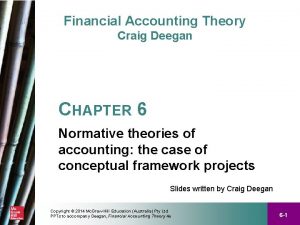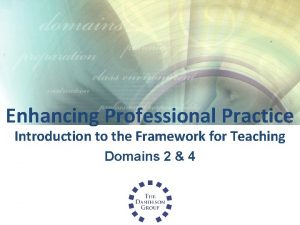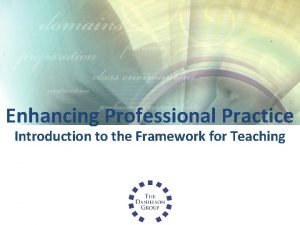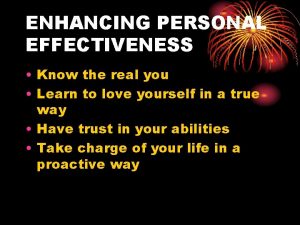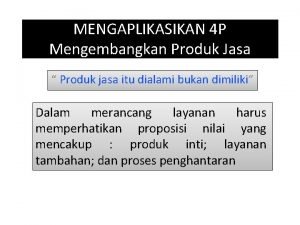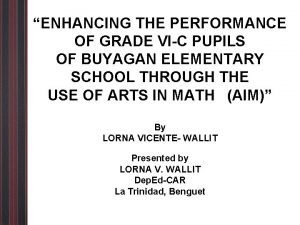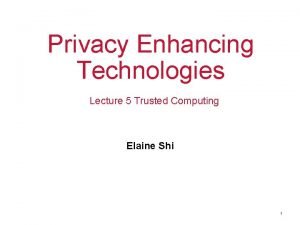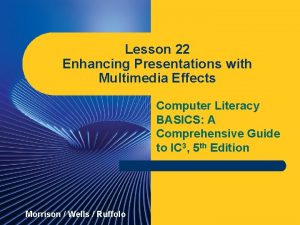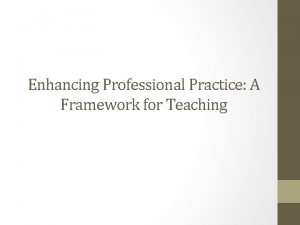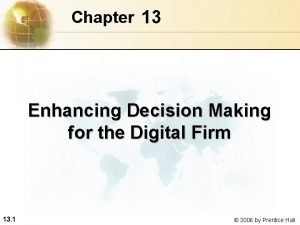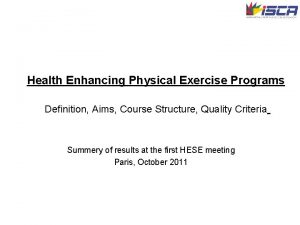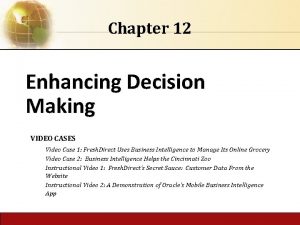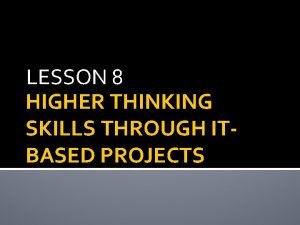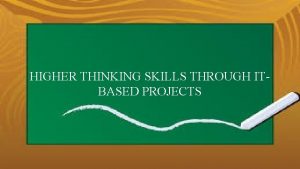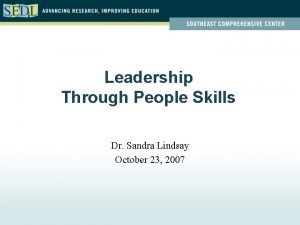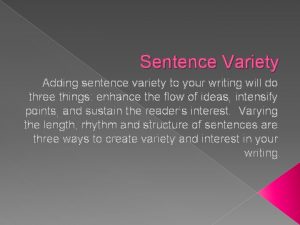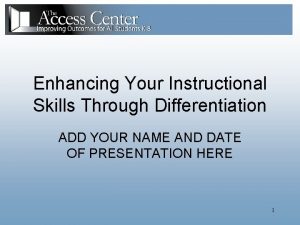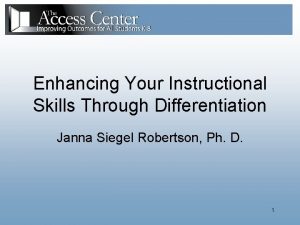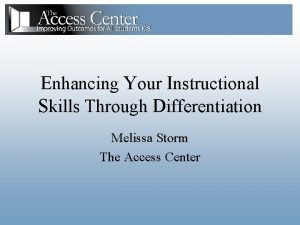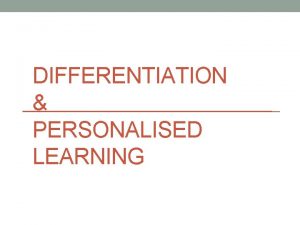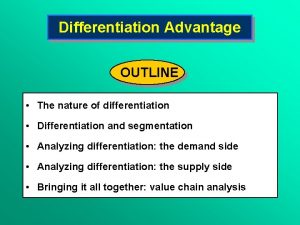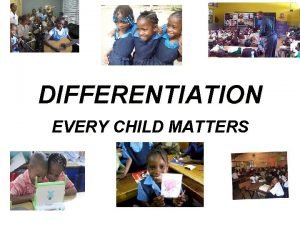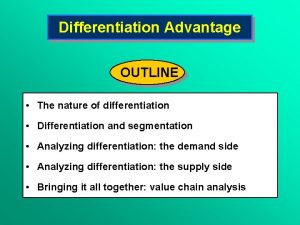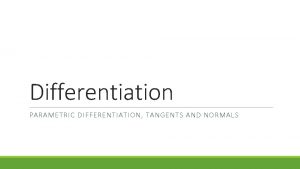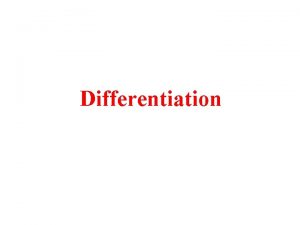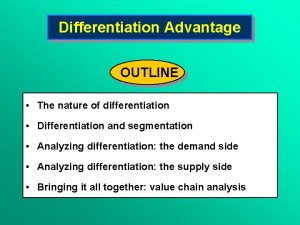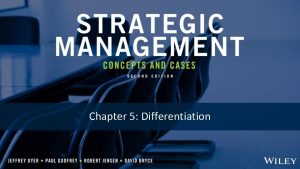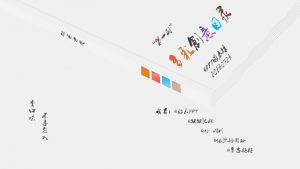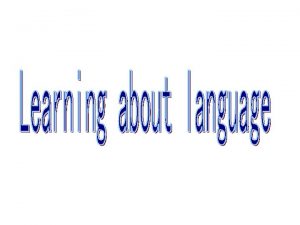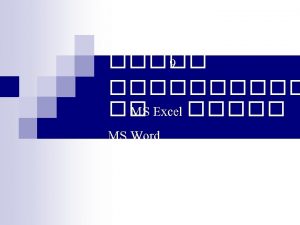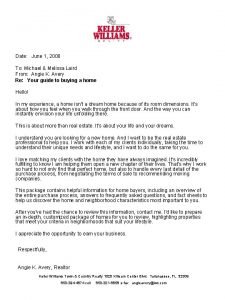Enhancing Your Instructional Skills Through Differentiation ADD YOUR




























- Slides: 28

Enhancing Your Instructional Skills Through Differentiation ADD YOUR NAME AND DATE OF PRESENTATION HERE 1

Session Overview What Is Differentiation? Differentiation Strategies Differentiation Practice Tips for Implementing Differentiated Instruction Resources 2

Objectives Participants will • Gain an overview of differentiated instruction; • Be able to implement several differentiation strategies; and • Identify things to consider when implementing differentiation at the classroom, school, and district level. 3

Why Differentiate? • All kids are different. • One size does not fit all. • Differentiation provides all students with access to all curriculum. 4

What Is Differentiation? • A teacher’s response to learner needs • The recognition of students’ varying background knowledge and preferences • Instruction that appeals to students’ differences 5

Teachers Can Differentiate Content Process Product According to Students’ Readiness Interest Learning Profile Adapted from The Differentiated Classroom: Responding to the Needs of All Learners (Tomlinson, 61999).

Comparing Traditional and Differentiated Classrooms • Consideration of student differences • Use of assessment • Use of student interest and learning style 7

Comparing Traditional and Differentiated Classrooms (continued) • Instructional format • Assignment options • Factors guiding instruction 8

Discussion Question What are you already doing to differentiate instruction in your classroom? 9

Differentiation Strategies • All strategies are aligned with instructional goals and objectives. • Specific strategy selection based on – Focus of instruction – Focus of differentiation 10

Differentiation Strategies (continued) Group 1: Compacting Group 2: Independent Study Group 3: Interest Centers or Interest Groups Group 4: Flexible Grouping 11

Example of a Differentiated Classroom Judy Rex’s Classroom in Scottsdale, AZ: • Multiage class of children in grades 3 and 4 • Reading levels from grade 2 through high school 12

Examples of Differentiation Strategies • Choice Boards • Tiered Activities • Learning Contracts 13

Diner Menu – Photosynthesis Appetizer (Everyone Shares) • Write the chemical equation for photosynthesis. Entrée (Select One) • Draw a picture that shows what happens during photosynthesis. • Write two paragraphs about what happens during photosynthesis. • Create a rap that explains what happens during photosynthesis. Side Dishes (Select at Least Two) • Define respiration, in writing. • Compare photosynthesis to respiration using a Venn Diagram. • Write a journal entry from the point of view of a green plant. • With a partner, create and perform a skit that shows the differences between photosynthesis and respiration. Dessert (Optional) • Create a test to assess the teacher’s knowledge of photosynthesis. 14

THINK-TAC-TOE Book Report Draw a picture of the main character. Perform a play that shows the conclusion of a story. Write a song about one of the main events. Write a poem about two main events in the story. Make a poster Dress up as your that shows the favorite character order of events in and perform a the story. speech telling who you are. Create a Venn diagram comparing and contrasting the introduction to the closing. Write two paragraphs about the main the setting. character. 15

Tiered Activity – Writing a Persuasive Essay 4 th– 6 th Grade Classroom Beginning Intermediate Advanced Outcome/ Objective Students will determine a topic and will write a five-sentence paragraph with a main idea, three supporting sentences, and a concluding sentence. Students will determine a topic, state a point of view, and write two paragraphs defending that point of view. Students will determine a topic, state a point of view, and write an essay of at least five paragraphs that uses multiple sources to defend that point of view. Instruction/ Activity Students will receive a model of a five-sentence paragraph and explicit instruction in constructing the paragraph. As a prewriting activity, students will list their topic and develop a list of at least three things that support their topic. Students will receive a model of a persuasive essay and a graphic organizer that explains the construction of a persuasive essay. Students will also receive explicit instruction in writing a persuasive essay. As a prewriting activity, students will use the graphic organizer to plan their writing. Students will review the graphic organizer for a persuasive essay. Students will be given explicit instruction in locating sources and quotes for their essays. As a prewriting activity, students will use the graphic organizer to organize their essay. Students will also compile a list of five sources that defend their main point. Assessment Students will be able to write a five-sentence paragraph that successfully states and supports a main idea. The paragraph will meet the criteria on the state writing rubric. Students will be able to state a point of view and successfully defend the idea using two paragraphs that defend the point of view using main ideas and supporting details. The paragraphs will meet the criteria on the state writing rubric. Students will be able to write a five-paragraph essay that states a point of view, defends the point of view, and uses resources to support the point of view. The essay will meet the criteria on the state writing rubric. 16

Learning Contract #1 Name ____________ My question or topic is: To find out about my question or topic… I will read: I will look at and listen to: I will draw: I will write: I will need: Here’s how I will share what I know: I will finish by this date: 17

Learning Contract #2 To demonstrate what I have learned about __________, I want to _ Write a report _ Put on a demonstration _ Set up an experiment _ Develop a computer presentation _ Build a model _ Design a mural _ Write a song _ Make a movie _ Create a graphic organizer or diagram _ Other This will be a good way to demonstrate understanding of this concept because _______________________________ To do this project, I will need help with _______________________________ My Action Plan is________________________ The criteria/rubric which will be used to assess my final product is ____________________________________ My project will be completed by this date _______________ Student signature: ________________ Date ___/___ Teacher signature: ________________ Date ___/___ 18

Differentiation Practice Differentiation Scenario 19

Differentiation Activity – Reading Your task is to take the following instructional objective and identify two differentiation strategies that might be used to teach the objective. Objective: Students will complete a report on the book Charlotte’s Web. Identify the pros and cons of using both strategies in a class of 25 students that includes these 5 students: Sherry likes to be asked to do things by the teacher. She is interested in fitting in and speaks out often in class. She has a wild imagination and loves to read, but her comprehension skills are below grade level. Jimmy is hyperactive and likes to dance around the room when class is near the end. He is an audio/visual learner, is a solid reader, and enjoys excelling and being the “best. ” He gets very excited to start new books, but they don’t hold his attention for long. Terrance does not feel a connection to school. He is a very intelligent student, but he “follows. ” He seems to do well in every type of activity when he applies himself. He has exhibited strong reading skills, but does not always complete work. Jack failed reading three times. He is an expert hunter and fisherman and knows more about the outdoors than anyone. He seems to learn best with hands-on activities. His reading and writing skills have only slightly improved over the last 2 years. Marie is a very quick learner. She seems to get things just by listening. She likes to excel. She is very concerned about rules and right vs. wrong. She is a natural leader. Her reading and writing skills are both above grade level. 20

Assessment in the Differentiated Classroom • • Ongoing Instruction-dependent Student-dependent Informative for continued instruction 21

Tips for Implementing Differentiated Instruction: Your Classroom • Start slowly. • Organize your classroom space. 22

Teacher Station 1 Inboxes Bookshelf Teacher Station 2 Schedule Group Assignments 23

Tips for Implementing Differentiated Instruction: Your Classroom (continued) • • Start student files. Start student portfolios. Use a clipboard. Use technology. 24

Implementing Differentiated Instruction: Your District or School • Start with committed staff. • Look for existing resources/infrastructure. • Start with one or two strategies. • Try it and be willing to alter and extend. 25

Implementing Differentiated Instruction: Additional Considerations • Teacher support • Professional development • Adequate planning time 26

Where Do I Go From Here? Resources • Listservs: • mstorm@air. org • Collaboration 27

Resources (continued) • Assessment: – Curriculum-based measurement www. studentprogress. org • National Center on Accessing the General Curriculum (NCAC): www. cast. org/ncac/ • Access Center: www. k 8 accesscenter. org 28
 Click to add titleclick to add subtitle
Click to add titleclick to add subtitle Click to add subtitle
Click to add subtitle Click to add titleclick to add subtitle
Click to add titleclick to add subtitle Four enhancing qualitative characteristics
Four enhancing qualitative characteristics Enhancing professional practice
Enhancing professional practice Danielson framework components
Danielson framework components Enhancing personal effectiveness
Enhancing personal effectiveness Contoh pengembangan produk jasa
Contoh pengembangan produk jasa Enhancing thermal conductivity of fluids with nanoparticles
Enhancing thermal conductivity of fluids with nanoparticles Enhancing the performance of grade vi-c
Enhancing the performance of grade vi-c Privacy-enhancing computation
Privacy-enhancing computation Property enhancing process in manufacturing
Property enhancing process in manufacturing Text box formatting
Text box formatting Enhancing professional practice a framework for teaching
Enhancing professional practice a framework for teaching Enhancing decision making
Enhancing decision making History of performance enhancing drugs
History of performance enhancing drugs Health enhancing physical activity definition
Health enhancing physical activity definition Enhancing decision making
Enhancing decision making By one man sin
By one man sin Furcation involvement
Furcation involvement Tangent-sawing
Tangent-sawing The night of the scorpion
The night of the scorpion Higher thinking skills through it-based projects
Higher thinking skills through it-based projects Higher thinking skills through it based projects
Higher thinking skills through it based projects Leadership through people skills
Leadership through people skills Intra vs interpersonal skills
Intra vs interpersonal skills What sre soft skills
What sre soft skills Ontario skills passport essential skills
Ontario skills passport essential skills Sentence structure variety
Sentence structure variety



